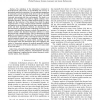Free Online Productivity Tools
i2Speak
i2Symbol
i2OCR
iTex2Img
iWeb2Print
iWeb2Shot
i2Type
iPdf2Split
iPdf2Merge
i2Bopomofo
i2Arabic
i2Style
i2Image
i2PDF
iLatex2Rtf
Sci2ools
PIEEE
2016
2016
Reconstructing Time-Dependent Dynamics
—The usefulness of the information contained in biomedical data relies heavily on the reliability and accuracy of the methods used for its extraction. The conventional assumptions of stationarity and autonomicity break down in the case of living systems because they are thermodynamically open, and thus constantly interacting with their environments. This leads to an inherent time-variability and results in highly nonlinear, timedependent dynamics. The aim of signal analysis usually is to gain insight into the behaviour of the system from which the signal originated. Here, a range of signal analysis methods is presented and applied to extract information about time-varying oscillatory modes and their interactions. Methods are discussed for the characterization of signals and their underlying non-autonomous dynamics, including time-frequency analysis, decomposition, coherence analysis and dynamical Bayesian inference to study interactions and coupling functions. They are illustrated by...
Related Content
| Added | 08 Apr 2016 |
| Updated | 08 Apr 2016 |
| Type | Journal |
| Year | 2016 |
| Where | PIEEE |
| Authors | Philip T. Clemson, Gemma Lancaster, Aneta Stefanovska |
Comments (0)

